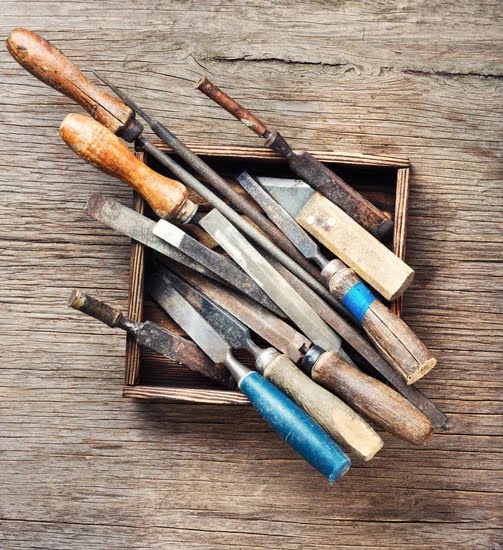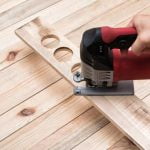If you’re a dog owner, you know just how destructive their chewing habits can be, especially when it comes to woodwork. Whether it’s gnawing on furniture legs or tearing apart door frames, this behavior can become not only frustrating but also costly. In this article, we will explore the reasons behind this destructive behavior and provide practical solutions to prevent your furry friend from chewing on your precious woodwork.
The potential dangers associated with your dog’s woodwork chewing cannot be overlooked. Not only does it damage your valuable belongings and tarnish the aesthetic appeal of your home, but it can also pose serious risks to your dog’s health.
Splinters or toxic substances that may be present in treated wood can cause harm if ingested, leading to digestive issues or even choking hazards. Therefore, timely intervention is crucial in addressing this behavior before it becomes a habit that is hard to break.
Understanding why dogs chew on woodwork is essential in finding effective preventive measures. Dogs are natural chewers due to their inherent instincts and behaviors. Chewing helps them relieve stress and anxiety while also providing mental stimulation and dental hygiene benefits. Identifying potential triggers and stressors that contribute to their chewing habits is key in eliminating or redirecting this behavior towards more suitable alternatives.
In the following sections, we will delve deeper into the root causes of woodwork chewing and discuss various strategies for prevention. By giving you insights into establishing a puppy-proof environment, offering physical and mental stimulation, employing proper training techniques, utilizing bitter taste deterrents, implementing positive reinforcement, and seeking professional help when needed, we aim to equip you with all the tools necessary for successfully preventing your dog from chewing woodwork.
With patience, consistency, and persistence in implementing these strategies, both you and your furry companion can enjoy a harmonious coexistence while preserving the integrity of your woodwork.
Why Dogs Chew
Exploring the underlying causes
Understanding why dogs chew on woodwork is crucial in developing effective prevention strategies. Dogs may chew on woodwork due to various reasons, including teething, stress, anxiety, boredom, or simply because it’s a natural behavior for them. Teething is a common cause of chewing in puppies as their gums can feel sore and uncomfortable during this period. It is essential to provide appropriate chew toys during this phase to redirect their chewing behavior onto safe objects.
Understanding natural instincts and behavioral patterns
Dogs have natural instincts to chew which can be traced back to their ancestors. Chewing helps them keep their teeth clean and healthy and also provides mental stimulation. Understanding these instincts and behavioral patterns can help in finding alternative outlets for their chewing needs. Furthermore, some dog breeds may have a stronger inclination towards chewing than others, so it’s important to take their breed characteristics into consideration.
Identifying potential triggers and stressors
Stressors and triggers can significantly contribute to a dog’s chewing behavior. Changes in routine, separation anxiety, lack of exercise or mental stimulation, or even an underlying medical condition could be potential triggers for your dog’s destructive behavior. By identifying these triggers, you can minimize or eliminate them from your dog’s environment, reducing the likelihood of woodwork chewing.
It’s important to remember that each dog is unique and may have different motivations behind their woodwork-chewing behavior. Taking the time to understand your dog’s specific needs and addressing any underlying issues will go a long way in preventing this destructive habit.
Puppy Proofing
Puppies are notorious for their curiosity and penchant for chewing on anything they can get their teeth on, including woodwork. To prevent your puppy from wreaking havoc on your home, it is crucial to create a safe environment through effective puppy-proofing measures.
One of the most important steps in puppy proofing is preventing access to woodwork using barriers and baby gates. Identify areas in your home where woodwork is present and install sturdy barriers or use baby gates to block off these spaces.
This will limit your puppy’s access and minimize the temptation to chew on woodwork. It is also essential to supervise your puppy closely when they are not confined to a designated area, redirecting their attention away from woodwork if necessary.
In addition to physical barriers, designating a dog-proofed area where your pup can freely roam and play can be beneficial. Create a space that is equipped with appropriate toys, bedding, water, and food bowls. Make sure this area does not have any accessible woodwork that could be potentially damaged. By providing a designated space for your puppy’s activities, you are giving them an outlet for their energy and reducing the likelihood of destructive behavior elsewhere in your home.
Remember that preventing woodwork chewing requires an ongoing commitment, especially during the teething phase. Puppies go through this phase between three and seven months old when their permanent teeth start coming in. During this time, puppies experience discomfort as new teeth push through their gums, leading them to chew on objects like woodwork for relief. Providing appropriate chew toys specifically designed for teething puppies can help alleviate discomfort while protecting your valuable woodwork.
By implementing puppy-proofing measures such as using barriers or baby gates, creating a dog-proofed area, and providing appropriate chew toys during teething periods, you can effectively prevent your furry friend from chewing on your woodwork. These proactive approaches set the stage for success by creating a safe environment that promotes positive behavior.
Physical and Mental Stimulation
One of the main reasons dogs chew on woodwork is due to boredom and excess energy. Dogs are naturally active animals that require both physical and mental stimulation to thrive.
When they do not receive enough exercise or engagement, they may turn to destructive chewing as a way to alleviate their boredom or release pent-up energy. By incorporating physical and mental stimulation into your dog’s routine, you can help prevent woodwork chewing and promote a healthier lifestyle for your furry friend.
To tackle boredom and excess energy, it is important to provide your dog with plenty of opportunities for exercise. Regular walks, runs, or play sessions in the park will not only tire out your dog physically but also provide mental stimulation by allowing them to explore new environments and interact with other dogs.
In addition to exercise, offering a variety of engaging toys and interactive puzzles can keep your dog occupied when you are unavailable to play with them. Puzzle toys that dispense treats or challenge them mentally can be especially beneficial in redirecting their focus from the woodwork to more appropriate outlets for their energy. Rotating toys regularly can also help maintain their interest and prevent boredom.
To further stimulate your dog mentally, consider introducing obedience training or agility exercises. These activities not only provide mental challenges but also strengthen the bond between you and your pet. Learning new commands or navigating through obstacle courses can help redirect their energy towards more constructive behaviors.
By providing both physical and mental stimulation, you can help prevent boredom-induced woodwork chewing in your dog. Remember, every dog is unique, so it may take some trial and error to find the right balance of activities that keep your pup engaged and satisfied. It’s important to monitor their behavior closely so you can adjust their routine accordingly if needed.
Overall, preventing woodwork chewing requires a multifaceted approach that addresses the underlying causes behind this behavior. By understanding why dogs chew, creating a safe environment, implementing proper training techniques, incorporating bitter taste deterrents, and seeking professional help when needed, you can successfully prevent your dog from chewing woodwork and foster a harmonious coexistence with your canine companion.
Proper Training Techniques
One of the most effective ways to prevent your dog from chewing on woodwork is by teaching them the “Leave It” command. This command can help redirect your dog’s attention away from the woodwork and onto something more appropriate. Here are some proper training techniques to successfully teach your dog the “Leave It” command:
- Start with basic obedience training: Before introducing the “Leave It” command, it’s important to establish a foundation of basic obedience training with your dog. This includes commands such as “sit,” “stay,” and “come.” By having a solid foundation, your dog will be more receptive to learning new commands like “Leave It.”
- Introduce the command gradually: Begin by using treats or toys that your dog finds enticing but won’t harm them if chewed. Hold the treat or toy in your closed hand and say “Leave It” firmly but calmly. Wait for your dog to lose interest in trying to get the item and reward them with praise and a different treat or toy.
- Add verbal and visual cues: As your dog becomes more familiar with the “Leave It” command, start incorporating verbal and visual cues. For example, you can hold your hand out flat in front of their face while saying “Leave It.” This will help them associate both the verbal cue and visual cue with the desired behavior.
- Practice in different environments: Once your dog understands the concept of leaving items alone when told, it’s important to practice in various settings. Move around different rooms in your house or take them outside on walks where there may be distractions like other animals or interesting smells. This will help reinforce their understanding of the command in different scenarios.
- Consistency is key: To effectively teach the “Leave It” command, consistency is essential. Always use the same cue words, hand signals, and rewards during training sessions. Be patient and persistent with your dog’s progress, as it may take time for them to fully grasp the command.
By consistently practicing these proper training techniques, you can successfully teach your dog the “Leave It” command and prevent them from chewing on woodwork. Remember to always use positive reinforcement and reward good behavior to create a harmonious coexistence with your furry friend.
Bitter Taste Deterrents
Exploring Natural and Commercial Bitter Sprays
One effective approach to prevent dogs from chewing woodwork is to make it unappealing by using bitter taste deterrents. These deterrents are designed to discourage dogs from chewing on surfaces by creating a taste that they find unpleasant. There are both natural and commercial options available on the market.
Natural bitter sprays can be made at home using ingredients such as apple cider vinegar, lemon juice, or cayenne pepper. These concoctions can be sprayed onto the woodwork to create a strong, bitter taste that dogs will avoid. It’s important to note that while natural deterrents can be effective for some dogs, their efficacy may vary depending on the individual dog’s preferences and sensitivities.
Commercial bitter sprays are also widely available and can be purchased online or at pet stores. These products are specifically formulated with safe ingredients that have an unappealing taste for dogs. Most commercial sprays come in easy-to-use spray bottles, making it convenient to apply them onto the woodwork surfaces. It is advisable to read product labels and choose a reputable brand that has positive reviews from other dog owners.
Tips for Proper Application and Effectiveness of Deterrents
To ensure the effectiveness of bitter taste deterrents in preventing woodwork chewing, proper application is key. Here are some tips for applying these deterrents:
- Clean the surface: Before applying any spray, make sure to clean the woodwork thoroughly. Remove any dust, debris, or previous chewing marks to ensure maximum adherence of the deterrent spray.
- Test in inconspicuous areas: Before spraying all over the woodwork, test the deterrent on a small, inconspicuous area first to check for any adverse reactions or potential discoloration.
- Apply generously: Spray the deterrent generously onto the woodwork so that it creates a strong, noticeable taste. Make sure to cover all the areas where your dog tends to chew.
- Reapply as needed: Bitter taste deterrents may lose their effectiveness over time or after exposure to moisture. Therefore, it is important to reapply them regularly as directed by the product instructions or when you notice your dog showing interest in chewing again.
- Use positive reinforcement: When applying the deterrents, be sure to provide alternative chew toys or treats that are acceptable for your dog to chew on. This will redirect their attention and reinforce desired behavior.
Gradually Weaning the Dog off the Bitter Taste through Positive Reinforcement
Although bitter taste deterrents can effectively discourage dogs from chewing woodwork, it is important to gradually wean them off the aversion by providing positive reinforcement for desired behaviors. Once your dog stops showing interest in chewing on the woodwork, it’s crucial to reward them with treats, praise, and attention. This positive reinforcement will help them associate good behavior with rewards and create a long-lasting behavioral change.
Over time, as your dog becomes accustomed to avoiding the woodwork due to bitter taste deterrents and consistently receives positive reinforcement for appropriate behavior, you can gradually reduce the use of these sprays. Eventually, your dog will understand that chewing on woodwork is not desirable and develop a preference for appropriate chew toys instead.
Remember that consistency is key in this process. By consistently applying bitter taste deterrents and reinforcing alternative behaviors, you can effectively make woodwork unappealing for your dog and prevent further damage while ensuring their overall well-being.
Positive Reinforcement
In order to effectively prevent dogs from chewing woodwork, it is important to use positive reinforcement to encourage and reward good behavior. Positive reinforcement is a training technique that involves rewarding desired behaviors in order to increase the likelihood of those behaviors being repeated. This section will focus on the benefits of positive reinforcement and how it can be used to deter woodwork chewing.
Positive reinforcement plays a crucial role in training dogs because it helps them understand what behaviors are desirable and encourages them to continue exhibiting those behaviors. When a dog receives praise, treats, or other rewards for not chewing on woodwork, they learn that this behavior is deemed acceptable by their owner. This helps establish a strong bond between the dog and their owner, as well as foster trust and compliance.
One effective way to use positive reinforcement in preventing woodwork chewing is by providing alternative activities that redirect the dog’s attention away from the woodwork. For example, when you catch your dog engaged in an appropriate behavior such as playing with their toys or lying on their designated bed, immediately praise and reward them with treats or verbal affirmations. This will help reinforce the idea that engaging in these activities is more rewarding than chewing on woodwork.
In addition to rewards, consistency is key when using positive reinforcement. It is important to be consistent with your rewards and expectations so that your dog understands what behaviors are being reinforced. For example, if you only reward your dog occasionally for not chewing on woodwork, they may become confused about which behaviors are acceptable. By consistently rewarding good behavior and ignoring or redirecting bad behavior, you can effectively communicate your expectations to your dog.
By implementing positive reinforcement techniques and rewarding good behavior consistently, you can create an environment where woodwork chewing becomes less appealing for your dog. Remember that patience and persistence are key during this process, as it may take some time for your dog to fully understand what behaviors are rewarded. With time and consistency, positive reinforcement can be a powerful tool in preventing woodwork chewing and fostering a harmonious coexistence with your dog.
| Benefits of Positive Reinforcement | How to Use Positive Reinforcement to Prevent Woodwork Chewing |
|---|---|
| – Establishes a strong bond between the dog and owner | – Provide alternative activities to redirect attention away from woodwork |
| – Fosters trust and compliance in the dog | – Immediately praise and reward the dog for engaging in appropriate behaviors |
| – Helps dogs understand what behaviors are desirable | – Be consistent with rewards and expectations |
Seeking Professional Help
When dealing with a dog that consistently chews on woodwork despite your best efforts, seeking professional help may be necessary. While preventive measures and training techniques can be effective for many dogs, some may require additional assistance to overcome their woodwork-chewing behavior. Here are some signs that indicate it’s time to consult with a certified dog trainer or animal behaviorist:
- Persistent and severe chewing: If your dog continues to chew on woodwork even after implementing preventive measures and consistent training, it could indicate an underlying behavioral or psychological issue.
- Anxiety or stress-related behaviors: Woodwork chewing can be a manifestation of anxiety or stress in dogs. If you notice other signs of anxiety, such as excessive barking, whining, destructive behavior when left alone, or aggression, it is recommended to seek professional help.
- Lack of progress: If you have been diligently following preventive strategies and training techniques but haven’t seen any improvement in your dog’s woodwork-chewing behavior over an extended period, professional guidance may be necessary.
Consulting with a certified dog trainer or animal behaviorist can provide valuable insights into the root causes behind your dog’s woodwork-chewing behavior and offer customized solutions based on your specific situation. They will conduct a comprehensive assessment of your dog’s behavior and environment to identify any underlying triggers and stressors that might contribute to the problem. They can also assist in developing a tailored management plan that addresses your dog’s specific needs.
In addition to seeking professional help, it is important to remember that overcoming woodwork chewing requires patience, consistency, and persistence from both the owner and the dog. By working closely with a professional and implementing their recommendations, you increase the chances of finding a solution that leads to a harmonious coexistence with your canine companion.
| Signs That Professional Help Might Be Necessary |
|---|
| Persistent and severe chewing |
| Anxiety or stress-related behaviors |
| Lack of progress despite preventive measures and training techniques |
Conclusion
In conclusion, preventing your dog from chewing on woodwork is essential for maintaining a harmonious living environment and safeguarding the integrity of your home. Through understanding the underlying causes and motivations behind this behavior, implementing proactive measures, providing mental and physical stimulation, using effective training techniques, applying bitter taste deterrents, and utilizing positive reinforcement, you can successfully address this destructive habit.
It is crucial to remember that prevention requires patience, consistency, and persistence. By creating a safe environment through puppy proofing and setting up barriers, you can limit access to woodwork. Additionally, providing your dog with engaging toys and regular exercise helps combat boredom and excess energy.
Proper training techniques, such as teaching the “Leave It” command using positive reinforcement methods, can effectively discourage woodwork chewing behaviors. Bitter taste deterrence sprays also serve as an effective tool to make woodwork unappealing to dogs. It is important to gradually wean them off the taste by reinforcing positive behaviors.
Finally, if prevention efforts are not yielding satisfactory results or if the behavior becomes uncontrollable or excessively destructive, seeking professional help from a certified dog trainer or animal behaviorist is recommended. They can provide comprehensive assessment of the situation and offer customized training plans to address your dog’s specific needs.
By implementing these strategies and tips outlined in this article consistently and persistently, you can look forward to a bright future where your woodwork remains intact and undamaged. Remember that a harmonious coexistence with your canine companion starts with addressing their chewing behaviors early on and investing in their mental and physical well-being.
Frequently Asked Questions
How do I get my dog to stop chewing on wood?
To get your dog to stop chewing on wood, it is important to provide them with appropriate chew toys and redirect their attention towards these acceptable alternatives. Make sure to offer a variety of chew toys, such as rubber or nylon bones, puzzle toys, or durable ropes that can satisfy their natural urge to chew.
It’s also beneficial to limit access to wooden objects by blocking off certain areas or using deterrent sprays that have a bitter taste, which will discourage your dog from chewing on the wood. Additionally, ensure that your dog receives enough physical exercise and mental stimulation throughout the day so they are not bored or looking for alternative activities like chewing on wood.
How do I get my dog to stop chewing baseboards?
Chewing baseboards can be frustrating, but it is essential to understand why your dog engages in this behavior. Dogs may chew baseboards due to boredom, anxiety, teething, curiosity, or even lack of appropriate chewing outlets. Firstly, increase exercise and playtime with your dog so they are tired and less inclined to find other objects to chew on.
Provide them with interactive toys that dispense treats or mental stimulation puzzles as these will keep their minds occupied. Providing plenty of chew toys made specifically for dogs can help divert their attention from baseboards as well. Additionally, consider using taste deterrents specifically designed for deterring dogs from chewing on household items.
Why does my dog chew my woodwork?
Dogs may chew woodwork due to various reasons such as teething discomfort, separation anxiety, boredom, attention-seeking behavior, insufficient exercise or mental stimulation, or a lack of appropriate chew toys. It’s important to address the underlying cause when trying to prevent this behavior rather than solely focusing on the symptoms. Ensure that your dog has access to a wide range of safe and durable chew toys that are suitable for their size and age.
Spend quality time engaging in interactive play sessions with your dog and provide regular opportunities for physical exercise and mental enrichment through activities like walks or obedience training sessions. If separation anxiety is the cause, gradually desensitizing your dog to being alone and crate training them when you’re away can be helpful. Additionally, consider using taste deterrents on the woodwork or temporarily block access to areas where they tend to chew while you work on redirecting their chewing behavior.

Hi everyone! I’m a woodworker and blogger, and this is my woodworking blog. In my blog, I share tips and tricks for woodworkers of all skill levels, as well as project ideas that you can try yourself.





